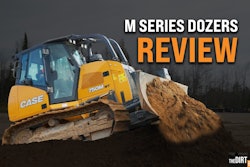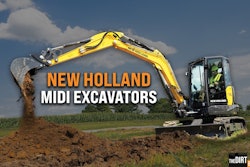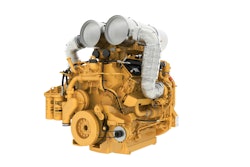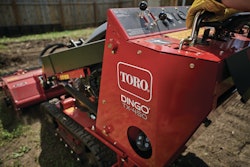On this episode of The Dirt, we focus on Kubla Cubed, an earthworks estimating software that’s designed to be accurate, simple and affordable.
The program is made for earthworks contractors and estimators who aren’t engineers or trained in CAD for determining preconstruction bids for cut-and-fill earthworks jobs, says guest Ted Woods, Kubla Ltd. co-founder.
Bryan Furnace, host of The Dirt and a construction contractor, reports he was able to design a pond in about 30 minutes, learning how to use the software from the company’s YouTube videos.
Kubla strives to keep the prices low, with an annual professional subscription costing $295. There is also a free version for simple earthworks estimating jobs.
To learn more about Kubla Cubed, check out the latest edition of The Dirt.
Equipment World serves up weekly videos on the latest in construction equipment, work trucks and pickup trucks – everything contractors need to get their work done. Subscribe and visit us at equipmentworld.com!
In This Episode:
- 00:00 – Kubla Cubed Earthworks Estimation Software
- 00:30 – What Is Kubla Cubed?
- 01:19 – Kubla Cubed Capabilities
- 02:13 – Kubla Cubed Workflow
- 03:27 – Import Process Speed
- 05:35 – Ease of Use
- 09:54 – Kubla Cubed Price
- 13:04 – Final Thoughts
00:00:00:02 - 00:00:20:21
Bryan Furnace
Hi, everybody. Welcome back to Equipment World. You're watching The Dirt. I'm your host, Bryan. And today we're here to talk about software. And if you've ever looked into software, you quickly realize the waters are deep and these programs are expensive. But today, we have a solution for you. Something that can fill the gap that isn't going to cost you an arm and a leg and isn't going to take six months to a year to actually learn the software.
00:00:20:23 - 00:00:30:06
Bryan Furnace
Without further ado, here is Ted from Kubla Cubed.
00:00:30:07 - 00:00:38:09
Bryan Furnace
So my first question is, for those not familiar with the software, can you give us just a general overview of Kubla Cubed and what it does?
00:00:38:11 - 00:01:03:13
Ted Woods
Yeah, Kubla Cubed is, product for calculating, earthworks volumes. It's aimed at earthworks contractors and estimators, trying to prepare bids like pre-construction bids for cut and fill. So, it supports both CAD and PDF workflows. And it's sort of aimed at the more sort of affordable end of the market. And one of our main things is easy to use.
00:01:03:15 - 00:01:15:01
Ted Woods
So those are two there's obviously a lot of competition. I don't know if, you know, the general landscape is quite competitive, but ours is kind of the I don't like to use what budget but the affordable end of thing.
00:01:15:03 - 00:01:32:09
Bryan Furnace
Yeah, absolutely. And we will dive into that here in just a minute. For starters though, can you talk a bit about some of the capabilities of the software? Is this something that you really need to have some sort of a either CAD file or PDF, or are there some free hand design tools available as well?
00:01:32:11 - 00:01:54:03
Ted Woods
Yeah, there are some free hand design tools, especially when it connects to the proposed. So you can use it for sort of prototyping different ideas, especially things like detention ponds, like building pads, this kind of, simple earthworks. The most of our customers are doing a PDF take offs. Some are using cards. But it does have that capability for designing as well.
00:01:54:03 - 00:02:10:19
Ted Woods
So and that's something we're working on from feedback from a lot of people. They want for us to put more effort into the design tool. So we're working on that quite a lot. So yeah. PDF take off is the main core component. And then we've got CAD, which is becoming more popular now. And also for design.
00:02:10:21 - 00:02:12:16
Ted Woods
It can be used as well.
00:02:12:18 - 00:02:23:21
Bryan Furnace
Can you give us at a very high level, very briefly, what's kind of your workflow process with this software? If I've got if I've got a set of PDF drawings, what's kind of my workflow.
00:02:23:23 - 00:02:43:23
Ted Woods
Yeah. The basic setup, a majority of projects we see will be you've got either, you might have multiple pages. So that's one challenge straight away. So you need to stitch or overlay your plans. But most hands will have an existing grade and then your proposed grade. So what we do is we have a process where we do the site plans.
00:02:43:23 - 00:03:07:13
Ted Woods
Then you define your existing topography. Then you do you propose. And there's usually a final step which is adjusting your finish levels. Because most plans will have marked finish levels, you need to adjust these down subgrade. So we take care of that process. And then finally we're producing export. So that's the kind of the mainstream workflow that we see, with the software.
00:03:07:13 - 00:03:25:14
Ted Woods
But there's a lot of other, workflows like for using and utility trenches or doing foundations is another area which would be quite different. So, it's kind of like a volumetric calculator, so we can do a lot of things, but that's the main thing it does. That's the main thing that customers need at the moment.
00:03:25:16 - 00:03:34:05
Bryan Furnace
Gotcha. And how quickly is the import process for those plans? Is that relatively automated or is it still fairly manual? How does that work?
00:03:34:05 - 00:03:52:15
Ted Woods
Yeah, I mean, it can be I'd like to be able to say, oh, it's just a one click process. But that's a big part of the challenge is, taking the data, which can often be incomplete or difficult to access. We and a number of other software companies have these PDF factor extraction routines, which can help pulling out the controls.
00:03:52:17 - 00:04:12:23
Ted Woods
We have tools for setting the controls. So on a good day it can be ten minutes on a on a bad day it can take a bit more. But like that's kind of our job is creating these tools to make it's like a challenging process. Like you've got PDF plans with some incomplete information, spread a lot of different sheets, and it's like we pull it all together and try and simplify.
00:04:12:23 - 00:04:31:22
Ted Woods
It is like, okay, here's our models in 3D. And then, you know, that's a big part of what we do is, making that process as quick as possible. So I can't say it's a super simple process, but I think estimate is know that is challenging. So our software to solve that problem as best as we can and what we're is improving as we go.
00:04:32:00 - 00:04:51:13
Bryan Furnace
I will say most software in my experience, is as much as everyone claims that it's this super quick automated click button deal, it never ends up being that way. There's always some manual component to it going in and tweaking and fixing, and you know, the software decides it's going to import something that shouldn't have been imported.
00:04:51:15 - 00:05:10:17
Ted Woods
Yeah, I mean, we have like the issue is the PDF isn't necessarily a great format for, transferring this kind of engineering drawings. Like it would be better to be doing in CAD with some standard, but there's not really the standards and they've not packaged in general. Actually, there's another format called IFC, which people are trying to push.
00:05:10:17 - 00:05:31:08
Ted Woods
But there's one thing in theory and there's another thing in practice. So yeah, that's the that's the issue. Yeah. We're getting there. And I mean, with things like AI and things in the future, maybe, maybe it will get faster. Every few years we improve our process. So what did take 2 or 3 hours three years ago now takes us half an hour to so far.
00:05:31:08 - 00:05:34:13
Ted Woods
And then hopefully we'll get down to ten minutes hopefully one minute.
00:05:34:15 - 00:05:54:14
Bryan Furnace
So my next question is can you talk about the ease of use. And this one really this one hits home for me because as soon as you, especially as a small contractor that doesn't really have, I don't have a dedicated estimator, I don't have a dedicated guy who went to engineering school and he's familiar with CAD. Can you talk about the ease of use?
00:05:54:14 - 00:06:04:22
Bryan Furnace
Because my experience with a lot of these take off software programs is you borderline need to go take a full-on course to even wrap your head around it.
00:06:05:00 - 00:06:38:13
Ted Woods
Yeah. I mean, are three sort of main points with the software is, accuracy. That's obviously number one. Affordability, ease of use. So these are those three things, three targets we had with the software. So it doesn't necessarily have all the features, but ease of use is really huge. So one benefit with our software compared to say, CAD software like you're describing is all just very targeted as we know, our users, earthworks contractors, it's a lot easier for us to say this tool needs to be for earthworks contractors.
00:06:38:13 - 00:06:54:12
Ted Woods
So there are just slight tweaks that you can make, like, we know that they'll be working feet or meters here. We know it's not like some cuts off or which is designed for doing a circuit board or doing, you know, a caravan design. And then, you know, it's got a different lot of different uses or it's always it's very targeted.
00:06:54:12 - 00:07:13:23
Ted Woods
So we can make the tools very specific and cut out tools that, earthworks estimates aren't going to have any useful. It's just that core tool that they need to get the job done. And so a lot of our customers do come from cross-section and grid methods with a spreadsheet. So that's been a big part, especially initially of where our customers came from.
00:07:14:00 - 00:07:31:02
Ted Woods
So we have that journey of like, okay, we can't throw CAD complexity at them. We've got to try something that they'll understand and try and keep it as simple as possible. That has been a useful process to like, find customers, use spreadsheets and then be like, how do we onboard them onto this new world of 3D models and all that kind of stuff?
00:07:31:04 - 00:08:00:23
Bryan Furnace
That's where my personal experience with the software was exactly that Kubla Cubed. I was able to step into that, and within a day or two of kind of fumbling around watching the content that you guys had online, I was very quickly able to import drawings, do some free hand work as well, figure out my volumetric calculations. In fact, I just designed upon in the software and to be able to, within a half hour, have a really good idea of how much material is going to be coming out of that hole.
00:08:01:01 - 00:08:10:20
Bryan Furnace
And it didn't take me six months to a year to figure out how to make it work in the software. I mean, that was huge, and that is a huge advantage over a lot of your competitors.
00:08:10:22 - 00:08:31:04
Ted Woods
Yeah. No, I mean, thanks for saying, Bryan. Yeah, I like your kind of, what what we would say is, kind of target audience in some ways is like smaller contractors. You haven't got tons of time to do training in CAD to kind of also the investment, especially if you're doing one job this month, maybe two, three months later, you're doing another job.
00:08:31:04 - 00:08:51:05
Ted Woods
You don't know when if you if you pay upfront for very expensive software and you can't make the money back, it's a it's a real problem. And YouTube's a big part of what we do as well. Like when we first started, there wasn't so many YouTube videos and we sort of, I think pushed that a lot because a lot of other companies had like their videos behind username and password you had to enter, whereas if at all.
00:08:51:05 - 00:09:06:03
Ted Woods
I was on YouTube for a month and a few recently, some of my colleagues have as well. So, we should be doing that, but I think that's all part of it. To make it easy to use software, you can't just make the software. You have to make the user manual. You have to do the YouTube videos.
00:09:06:05 - 00:09:30:00
Ted Woods
We do these getting started sessions for new users. So it's all, you know, it's all part of the experience to try and make it and hopefully with we seem to be succeeding in some ways. So we're getting a lot of new customers, but we've got a long way to go. We still recognize like, but some of the shows I know you've given some feedback about one in rectangles in the program, so we're going to try and put that into the next major release that we're working on.
00:09:30:02 - 00:09:46:06
Ted Woods
I've been thinking about how to fit that in, and I think I've worked right away. So that that's an example of how it works, that you say, okay, this is a real pain point for us. You so much better if you could do this. And we're like, oh, is it possible? Yeah. Like we can move this and move that and get it working.
00:09:46:06 - 00:09:52:20
Ted Woods
So, you know, you need that. You have to have that conversation with customers. Otherwise it's not going to it's not going to work.
00:09:52:22 - 00:10:12:01
Bryan Furnace
Yeah, absolutely. So my final question for you is really you've you've kind of skirted around it and touched on it a couple times, but it's my other favorite piece of the software. Can you talk about the affordability. Because that's the other huge pain threshold for us contractors, especially the small guys that aren't going to use this on a day-to-day basis.
00:10:12:03 - 00:10:15:13
Bryan Furnace
Is this sucker going to cost me $2,500 a year?
00:10:15:15 - 00:10:34:05
Ted Woods
No, I mean, the affordable part is quite important to us, like the prices are on the website. So the current prices are $295 USD per year, for the subscription. And there's another option, which is the Perpetual, which a lot of companies don't even sell perpetual now, but we do still and that is seven for one dollars.
00:10:34:07 - 00:10:47:09
Ted Woods
And the good thing about the Perpetual is, okay, it's more expensive upfront, but if you really on a budget, you can say, okay, I had a buy at one time, it does what I want more or less. And then in another 6 or 7 years I can upgrade. So that Perpetual gives a real good value for money if you don't upgrade.
00:10:47:09 - 00:11:05:12
Ted Woods
But if you do upgrade, you want to be on the latest version. The annual subscription is better, but we try and keep it, you know, affordable. Like my brother who came up with the original idea, he was like, oh, he was trying to design a school for a charity, right? And he was like, there's a lot of these high end, expensive programs out there which can do tons of stuff.
00:11:05:12 - 00:11:28:23
Ted Woods
You know, they could that very expensive is a lot of training, a lot of going through the tutorials. I just want something simple like paint for the US work. And so that's how we came up with the idea. And we still try to maintain that kind of ethos. And that's why we see, you know, the price point is quite important for us to be in that space, you know, so, yeah, affordable is, what we like to say.
00:11:28:23 - 00:11:54:09
Bryan Furnace
Yeah. It's and and you perfectly encapsulated it with that story. That is exactly how the software is. I mean, am I going to go design a super complicated civil project in Kubla Cubed? No, but man, for 99% of what I need as a small to mid-sized contractor to be able to do takeoffs, to be able to do some simplistic design to to be able to just pop into the software quickly.
00:11:54:14 - 00:12:10:04
Bryan Furnace
And if I don't remember something, I can go look up a video within 30s and remember how to do it. That's where you guys hit the nail on the head. It is just it's such an easy software relative to all of your other competitors in the marketplace. It is just very straightforward to use.
00:12:10:06 - 00:12:27:10
Ted Woods
Yeah, we do want to hold that space. Yeah. For things like that. You describe that Pons building parts. I mean it has been used for quite involved. That's what it's as well I think I've seen it on airports even, and big housing estates of like one hundreds plots. So is used in the higher end as well.
00:12:27:10 - 00:12:46:11
Ted Woods
And we're sort of pushing towards that space. We're thinking of splitting into two different products, like a professional and a sort of ultimate version, so we can keep the affordable factor and then cater for some of the more high-end tools. But yeah, I like the kind of one way I try to describe it is like a cut and fill calculator, but you've got your calculator area length counts.
00:12:46:11 - 00:13:02:17
Ted Woods
And then when it comes to 3D, people are like, I'm not quite sure how to do this, pond or ditch or, you know, swimming pool plots, these kind of things. And so it's like, fills that space, like, you just get it out quickly and within, you know, ten, 20 minutes, you should have a good, good estimate for your volumes.
00:13:02:19 - 00:13:03:14
Ted Woods
So. Yeah.
00:13:03:16 - 00:13:08:13
Bryan Furnace
Well, Ted, thank you so much for taking the time to talk to us about Kubla Cubed. This is awesome.
00:13:08:15 - 00:13:15:18
Ted Woods
Yeah. Thanks so much. Check out our website. Or we've also got a YouTube channel if you want to watch it in action. So. Yeah. Thanks again.
00:13:15:18 - 00:13:29:03
Bryan Furnace
Very well. Thank you again for Ted coming on the show to discuss the Kubla Cubed software with us and show you some of the capabilities that the software can do and how it can help your business. As always, I hope this helps you and your company. We'll catch you on the next episode of The Dirt.









